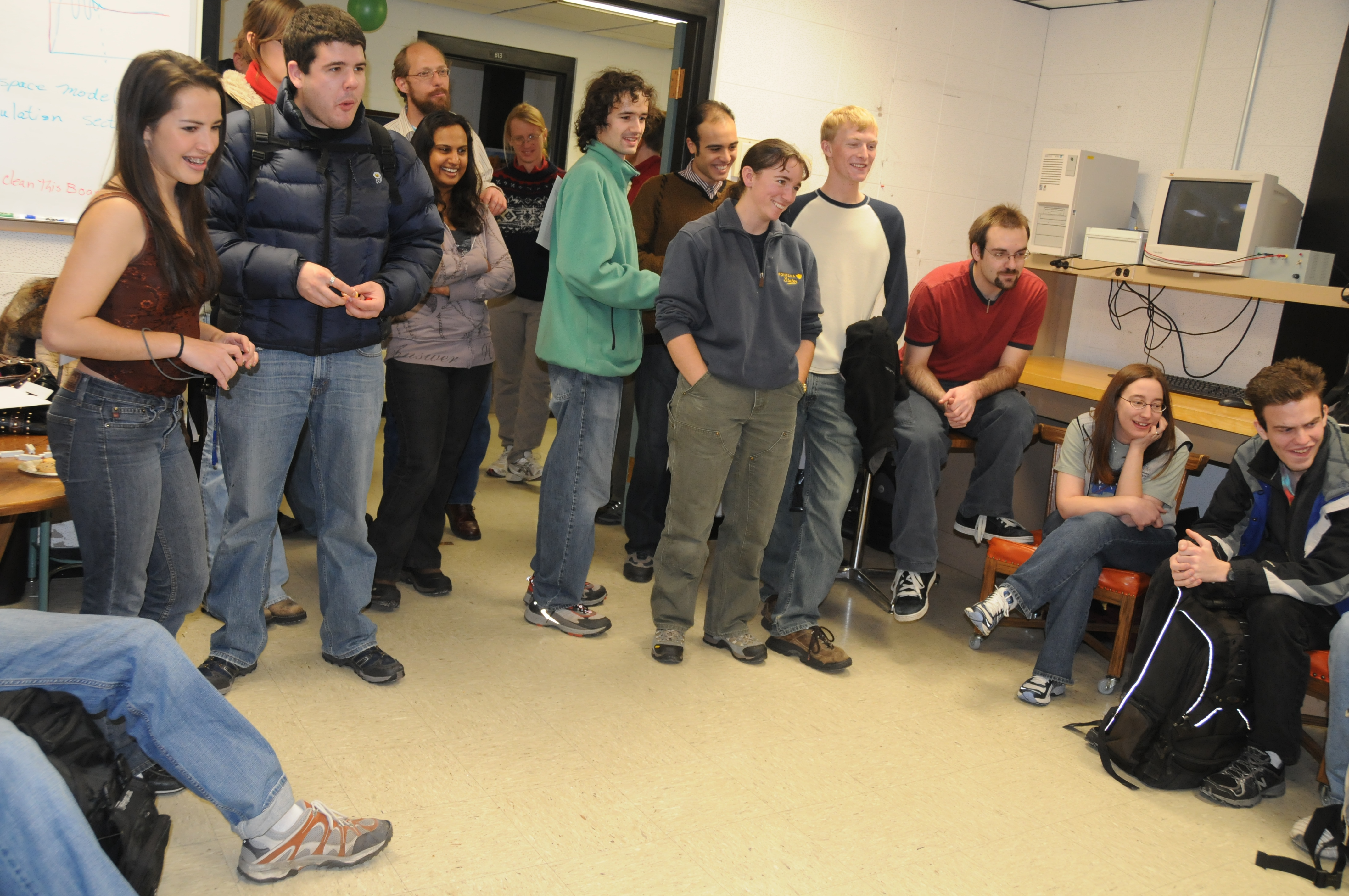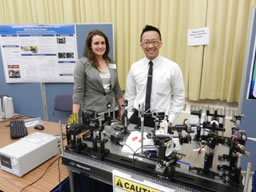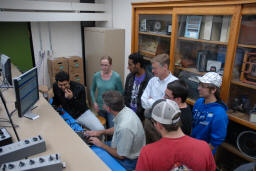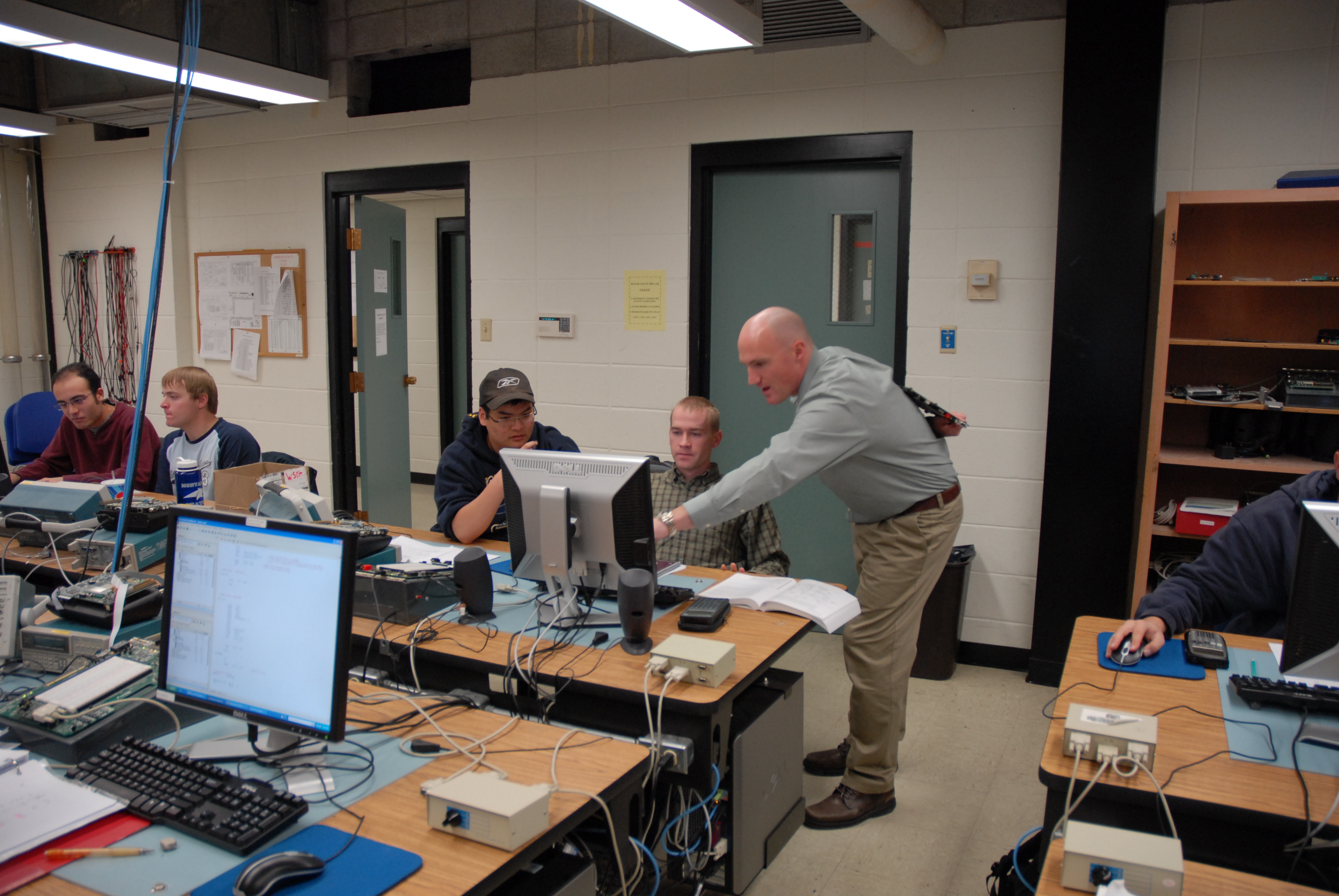Barrier/Gateway Courses Group
(Work completed 20131217)
Charge from the Provost
 "The purpose of this committee is to explore and develop recommendations to improve
the success of students in courses that typically impede progress in the major. This
may include strategies to improve student success in courses with high DWF rates or
courses that preclude entry into majors with capped enrollments (e.g., architecture,
nursing) and the potential transformation of developmental coursework to expedite
degree completion. The development of alternate curriculum pathways to the major (e.g.,
common core requirements that allow students to switch majors without losing credits)
should also be considered. Goal: reduced time to degree."
"The purpose of this committee is to explore and develop recommendations to improve
the success of students in courses that typically impede progress in the major. This
may include strategies to improve student success in courses with high DWF rates or
courses that preclude entry into majors with capped enrollments (e.g., architecture,
nursing) and the potential transformation of developmental coursework to expedite
degree completion. The development of alternate curriculum pathways to the major (e.g.,
common core requirements that allow students to switch majors without losing credits)
should also be considered. Goal: reduced time to degree."
Jump to: Preliminary Findings
Download: Final report (.pdf)
Barrier/Gateway Group Members
| Rob Maher, Group Convenor (Electrical & Computer Engr) [email protected] Joe Atwood (Ag Econ) [email protected] Harry Benham (Business) [email protected] Ken Bowers (Math) [email protected] Sarah Codd (Mechanical Engr) [email protected] Diane Donnelly (Univ Studies) [email protected] Jack Fisher (Sociology & Anthro) [email protected] |
Tom Hayes (Math) Erica McKay (MSU Student) David Parker (Political Science) |
Other key participants and contributors:
Group Email Reflector: |
Starting Points:
 Item 1: What MSU courses are in the "Barrier" category?
Item 1: What MSU courses are in the "Barrier" category?
The Montana State University Office of Planning and Analysis has a list of courses with large (50+) enrollments that have 25% or more of the students receive a D, F, or W grade. Using Fall 2009 through Spring 2012 (6 semesters), there are 92 different courses that appear at least once on this list. Among the 92 courses, there are 22 courses that appear in at least 4 of the past 6 semesters, and these are the courses this Barrier/Gateway Courses group focused upon.
Here are the 22 courses in alphabetical order by rubric, with the average DFW percentage per semester over the last six semesters:
- AMST 101D, Intro to American Studies (27%)
- BIOB 170IN, Principles of Biological Diversity (29%), also listed as "Organismal Biology"
- CAPP 120, Introduction to Computers (36%)
- CHMY 121IN, Intro to General Chemistry (37%)
- CHMY 141, College Chemistry I (35%)
- CSCI 111, Programming with Java I (34%)
- ECNS 101IS, Economic Way of Thinking (30%)
- EGEN 115, Engineering Graphics (31%)
- EGEN 116, Engineering Graphics Lab (36%)
- EGEN 203, Applied Mechanics (46%)
- M 065, Pre-algebra (39%)
- M 096, Survey of Algebra (39%)
- M 097, Surv of Alg (Mastery Learning) (44%)
- M 121Q, College Algebra (44%)
- M 145Q, Math for the Liberal Arts (29%)
- M 151Q, Precalculus (45%)
- M 161Q, Survey of Calculus (29%)
- M 171Q, Calculus I (47%)
- M 172Q, Calculus II (43%)
- M 273Q, Multivariable Calculus (31%)
- PSCI 210IS, Intro to American Government (34%)
- STAT 216Q, Introduction to Statistics (44%)
Item 2: What is the scope of the DFW issue at MSU?
Dr. Chris Fastnow (Planning and Analysis) did a review of the transcripts of all MSU students who received a bachelor’s degree in 2011-2012 to determine how many of those transcripts included one or more D, F, and W grades. The results Dr. Fastnow tabulated seem surprising:
- 65% of the graduates had 1 or more DFW grades.
- 50% of the graduates had 2 or more DFW grades. NOTE: Half of our recent MSU graduates have at least 2 DFW grades.
- 30% of the graduates had 4 or more DFW grades. NOTE: About a third of our MSU graduates have at least 4 DFW grades.
- 25% of the graduates had 5 or more DFW grades.
- 10% of the graduates had 10 or more DFW grades.
- 5% of the graduates had 14 or more DFW grades.
- 1% of the graduates had 20 or more DFW grades.*
Mean DFWs on the transcripts of last year’s baccalaureate degree recipients: 3.2. Median DFWs: 1
* One of our MSU graduates in 2012 had 41 DFW grades on the transcript. The fact that this particular individual actually stuck around and finished a degree is pretty remarkable.
Item 3: Is there really any harm in having courses with high DFW rates?
Traditionally, introductory “barrier” courses have been used as a way for a student
to gauge whether she/he is really cut out to pursue a particular degree program.
For example, a pre-med student who gets a D in chemistry, or an engineering student
who gets an F in calculus, might then want to consider other majors and degree options.
Some professors feel that having this serious message delivered as soon as possible
is better than having a student linger in a major for which there seems to be little
hope of success. On the other hand, throwing all the blame for DFW outcomes onto the
student may be disingenuous for us as professional educators. Are we really unable
to affect the performance in this regard? Maybe we can find alternative ways to boost
student learning by changing our course formats and instructional tactics. Examining
research results and successes from other institutions will be helpful here.
Item 4: What effect do DFWs have upon time-to-graduation?
Using the same DFW info for MSU's actual baccalaureate graduates from item 1, Dr. Fastnow determined the number of semesters needed to complete the degree. Although it is not completely correct to jump to the conclusion that there is a cause-effect relationship between DFWs and graduation speed, there is certainly a strong correlation. Assuming a standard 8 semesters to complete a baccalaureate degree, the data show a statistical ratio of roughly 0.3 additional semesters per DFW. Students with zero or 1 DFW average just over 8 semesters to complete BS/BA, while students with 4-5 DFWs average 10 semesters (i.e., one additional year). And keep in mind that this is for the students who actually graduated from MSU, so it does not indicate students who left MSU without completing a degree. Again, it is not correct to assume that graduation delays are attributable to DFWs, but the fact that the trends go hand-in-hand is useful information.
Item 5: What do professors think are the reasons that students have a high rate of DFW in these classes?
 Faculty definitely understand that the reasons for DFW outcomes are not always easy
to identify, and students earn a DFW in these classes for many reasons, not all things
MSU has control over. Here are some anecdotal comments collected so far:
Faculty definitely understand that the reasons for DFW outcomes are not always easy
to identify, and students earn a DFW in these classes for many reasons, not all things
MSU has control over. Here are some anecdotal comments collected so far:
- The student is simply unprepared for the course (e.g., lacks prerequisites).
- The student enrolls without really understanding what the course is about and what level of effort will be required.
- The student’s level of intellectual maturity is low: he/she does not recognize the signs of falling behind, does not seek help, and does not sufficiently allocate the time and effort necessary to succeed.
- The student has unexpected demands due to finances, family, emotional/psychological stress, etc., that prevent success.
- The student stumbles early in the class, then cannot keep up with new material while trying to catch up on old material.
- Instructor is ineffective: poor instructional skills and/or poor ability to motivate all students to succeed.
- The student “thinks” he/she is doing fine and doesn’t seek help or change study habits until it is too late.
- The student just gives up and stops attending the class at some point for reasons that are seldom known to the professor.
PRELIMINARY FINDINGS
Finding 1: A DFW outcome is not necessarily a bad thing
 Despite the implications of failure, a DFW grade can actually be a useful outcome
for some students. Students often enter MSU with a preconception about their fields
of study and perhaps an unrealistic expectation about the level of effort and talent
necessary to succeed in that field. MSU faculty feel that the experience leading
to a DFW provides a strong, practical signal that the student's talents, interests,
and abilities really lie in some other field. Moreover, faculty clearly expect MSU
students to be engaged and committed, shouldering their own share of responsibility
for academic achievement and success, and some students may not initially be ready
to take on that shared responsibility for learning. Enrolling in a formal class may
be the best way to find out his or her aptitude, although this can be at the risk
of earning a DFW grade.
Despite the implications of failure, a DFW grade can actually be a useful outcome
for some students. Students often enter MSU with a preconception about their fields
of study and perhaps an unrealistic expectation about the level of effort and talent
necessary to succeed in that field. MSU faculty feel that the experience leading
to a DFW provides a strong, practical signal that the student's talents, interests,
and abilities really lie in some other field. Moreover, faculty clearly expect MSU
students to be engaged and committed, shouldering their own share of responsibility
for academic achievement and success, and some students may not initially be ready
to take on that shared responsibility for learning. Enrolling in a formal class may
be the best way to find out his or her aptitude, although this can be at the risk
of earning a DFW grade.
Thus, we feel that MSU must continue to support mechanisms that enable our students to discover where their true interests, aptitudes, and talents lie, and among other things this means that some level of DFW outcomes will continue to be expected and accepted. It will be necessary to explain this to our external constituencies that may be inclined to view all DFW outcomes as a pedagogical failure, especially in forthcoming formulae for performance-based funding.
Finding 2: Influence of MSU policies on the rate of W grades
There are some indications that MSU's course withdrawal policies may unintentionally contribute to the traditionally high DFW rates in some courses. For example, one MSU policy allows students to enroll in more than 12 credits at no additional cost (the tuition "flat spot"), so a student signed up for 15 or more credits can drop a class without any financial penalty. Combined with the policy that permits students to withdraw from classes as late as the 13th week of the 15 week semester, some feel that MSU actually encourages students to over-enroll at no charge and then wait to see in which courses they’re doing the best and drop one or more of the others. Students may not realize that their financial aid will be curtailed if they do not successfully complete at least 67% of their cummulative credits, and a W counts against this percentage. Even if there is no tangible cost or penalty to the student for this behavior, it represents a real resource cost to MSU.
Several faculty have made the suggestion to adjust MSU's policies to reduce the casual use of the late drop policy. For example, one possibility might be:
-
First DFW grade on a student's transcript: optional career & aptitude counseling is offered to help the student identify interests and abilities, along with encouragement to attend a study skills workshop.
-
Second DFW grade on the transcript: above counseling is mandatory.
-
After the second DFW grade on the transcript, a student who repeats a course after previously receiving a W in that same course must pay full out-of-state tuition for those credits.
Other faculty suggest that MSU adopt a standard campus policy permitting a student to enroll in a particular course no more than twice. A third attempt would only be allowed in extraordinary circumstances, such as some sort of mitigating factor causing the second DFW in the class, or the student receiving significant academic intervention of some kind. Another possibility would simply be to detect students who have a second DFW in the same Barrier course and have active intervention in only those cases.
However, policy changes like these suggestions will require further examination to assess whether the cure may be worse than the disease. For example, mandatory counseling for every student with a second DFW could involve hundreds of students each semester. Limiting intervention only to DFW's received in required courses for a particular major might be a sensible refinement.
Finding 3: We should find out more about our students' true perceptions of how they ended up with a DFW outcome
 Our assumptions about why students do not succeed academically in certain courses
are largely based on faculty perceptions and accumulated anecdotes. The student perception
of the sequence of events leading to a DFW is hard to ascertain, either because the
individual student responds with a non-specific comment ("I was just too busy with my other classes to do well in this one") or an unhelpful defensive remark ("the TA hated me from the start"), or because their responses are not collected at all.
Our assumptions about why students do not succeed academically in certain courses
are largely based on faculty perceptions and accumulated anecdotes. The student perception
of the sequence of events leading to a DFW is hard to ascertain, either because the
individual student responds with a non-specific comment ("I was just too busy with my other classes to do well in this one") or an unhelpful defensive remark ("the TA hated me from the start"), or because their responses are not collected at all.
Moreover, providing a means to ensure a face-to-face conversation between a student with a DFW outcome and an appropriate university representative is essential, as well as making use of existing student survey mechanisms to help our institution better to understand the students' thought process.
Finding 4: Prospects for defining "curriculum pathways" that permit students to switch majors without significant loss of credits
MSU has several initiatives already underway:
- The Provost's Office, University Studies, and Planning & Analysis are preparing reports on change-of-major trends for MSU students (last 6 years) to determine what the most common changes are, so advising in those departments can be most effective. Also, info from this can help us overall in advising and also for planning course availability based on an awareness that certain majors may have a demand for upper-level coursework due to internal major changes that is higher than the entering freshmen numbers who declare the major initially.
- "Tracks" advising sheets are being developed for majors with specific math/science level requirements. For entering students who are not at the necessary level of proficiency, these designated pathways, or curricular tracks, will clearly indicate courses students can take based on their Math Level that will count for the major they've declared, as well as cover requirements for progress toward graduation. For example, the Pre-Med advisor has prepared a pre-med course track list based on the incoming student's math placement level. EHHD has created curricular tracks for their major options, and other programs are being encourage to do so. Diane Donnelly of University Studies will begin meeting with appropriate departments to help create and maintain the track lists.
- The Planning component of DegreeWorks can allow these tracks to be visible to students and show them the courses they should take based on their math score, science pre-reqs, etc.
- Math is a critical component in many MSU majors, so documenting which majors require which math classes can help students determine an appropriate route to select a major and to complete their degree.
Finding 5: Enforced prerequisites
Faculty specify prerequisites to set the entry knowledge expectation for a course. Students who do not meet the prerequisite requirements may struggle, or cause the instructor to spend time covering material that should only be review, but for which the non-prereq student is actually learning for the first time. An MSU policy requesting that the registrar turn on prerequisite-checking in Banner should be investigated as a way to reinforce the critical importance of prerequisites to subsequent course success.
Finding 6: Review and add prerequisites to all Barrier courses
Some of the identified Barrier courses have only pre-college prerequisites or no prerequisites at all. Faculty responsible for these courses should review the entry expectations and consider adding a prereq--even something like WRIT 101 or a University Seminar Core class--unless provisions are in place to accommodate the least-experienced students.
Finding 7: Reconsider the role and scope of freshman seminar (University Seminar Core category)
Freshman seminars are often viewed as an opportunity to help new students start on the right foot in college. However, some faculty feel that our Core University Seminar (US) courses have shifted away from emphasizing specific college survival skills like note-taking, studying, outlining, multiple revisions, and so forth. It is worth considering whether we can identify at-risk students and ensure that they develop appropriate survival skills before letting them loose into the various formal curricula. MSU endeavors to place students into appropriate math and writing levels based on standardized test scores and other screening, and it could be useful to apply similar strategies to identifying at-risk students and place them into specially designed and focused US Core courses.
Finding 8: Systematic orientation and expanded mentorship of new faculty
Like all universities, MSU has developed its own particular academic culture and climate, including high expectations for student achievement. A side-effect of these high expectations may be our numerous courses with high DFW rates. There is a sense that new MSU faculty can be better assisted in learning, thriving, and advancing our academic culture through ongoing orientation and mentorship so that they learn to deal with the wide range of student abilities we see on campus. This is particularly important for new faculty who will teach in the Barrier courses.
Finding 9: Special training and support for instructors and TAs who teach the identified Barrier courses
Not only new faculty, but current faculty (and TAs) can benefit from learning best-practices in teaching and learning for Barrier courses. It would be desirable to have a Barrier Courses Caucus for instructors in the identified courses so that they could meet a few times per year for specialized training--and encouragement.
Finding 10: Develop useful academic intervention strategies to lower the DFW rate
Looking at the array of Barrier courses at MSU, there appear to be at least three general categories. The first category comprises lower-division general core classes taken by a broad range of students, many of whom may be new freshmen. Category 2 contains the classes traditionally thought of as Barrier courses, namely, key foundational courses required for specific majors, such as Calculus being a key requirement of most STEM fields. Category 3 includes courses that are remedial (zero level) or of low-intensity compared to traditional college-level courses.
The DFW causes and reduction strategies may be different in each of these categories, as summarized below.
Category 1: Lower division general core classes taken by a broad range of students
- AMST 101D, Intro to American Studies (no prereqs listed; 150+ students per year, avg. 27% DFW)
- ECNS 101IS, Economic Way of Thinking (no prereqs listed, but Math Level III suggested; 1,100+ students per year, avg. 30% DFW)
- M 121Q, College Algebra (prereq M 096/097 or ACT 23 / SAT 540, or MPLEX Level III; Q course for potential STEM students needing refresher or more math background; 900+ students per year, avg. 44% DFW)
- M 145Q, Math for the Liberal Arts (prereq M 096/097 or ACT 22 / SAT 520 or MPLEX Level III; required for Ag Ed, general Q class for non-STEM students; taken by 500+ students per year, avg. 25% DFW)
- PSCI 210IS, Intro to American Government (no prereqs listed; taken by 350+ students per year, avg. 34% DFW)
Because these courses have only pre-college prerequisites and are often taken by our newest students, a primary concern for DFW intervention will be the needs of inexperienced students.
Category 1 issues summary
-
Many of the DFW-prone students may lack the essential college success skills assumed by the course instructor: note taking, critical reading and writing know-how, effective oral and written communication, experience with self-study and self-assessment , and so forth.
-
Some students may assume that they can coast through these classes easily because they took courses with similar names in high school: most high school curricula include coverage of American history, American government, algebra, and some introduction to the principles of economics. Thus, these students may misunderstand the higher level of intellectual effort needed to learn and to comprehend the college-level material.
-
Instructors for these courses may feel overwhelmed, isolated, under-appreciated, and possibly even defensive. Occasionally an instructor may even develop a siege mentality, feeling that he/she is solely responsible to uphold traditional standards in the face of incompetent, disinterested students, and to maintain traditional lecture decorum and parlance.
-
The typical large class sections may lead students into a sense of disengaged anonymity, causing them to de-value the importance of class attendance and engagement: "No one seems to care if I attend or not, and I think I can learn this stuff without attending lecture anyway."
Category 1 strategy summary
-
Develop better students: MSU must continue its diligence to develop academic success skills for ALL new students. Just like learning any new skill, improving one's study and learning skills requires practice, and MSU needs to ensure that inexperienced students participate in that practice.
-
Enhanced learning opportunities: develop recitation sections, active learning programs, on-line support material, etc. One existing example is ECNS 105, the 1 cr. study course companion created for ECNS 101. See paper by Wendy Stock, et al. This past year several of the funded Strategic Investment proposals involved special support in Barrier courses such as M 121, and this process should be expanded and carefully assessed for its impact on student success.
-
Initial advising: help ensure that students grasp that these courses are not re-runs of high school courses. Set high expectations and provide guidance on how successful students meet and exceed those expectations. It might even be a good idea if MSU changed the names of these courses in some way to differentiate them from the high school courses with similar names but different content and rigor.
-
Support the very best instructors: identify (and groom) a cadre of superior instructors whose creative interests embrace the scholarship of teaching and learning in these courses. These instructors would receive specific monetary and workload incentives and other special perquisites. MSU would also provide institutional assistance with research-based teaching methods, supervised recitation sections, and early intervention for students at risk for DFW.
-
Address the disengagement problem: along with superior instructors, consider ways to have students become part of an active and lively learning community--especially during the first few weeks of the course.
Category 2: Lower division classes specified as required for specific majors (key prerequisites)
- BIOB 170IN, Organismal Biology (no prereqs; required for biology, ecology, geology, paleontology, etc.; 500 students per year, 29% DFW )
- CHMY 121IN, Intro to General Chemistry (prereq placement at math Level 3; required for nursing, ag ed, sustainable food and bio, etc.; 800 students per year, 37% DFW)
- CHMY 141, College Chemistry I (prereq placement at math Level 4; required for chemistry, most engineering, physics, biology, HHD, etc.; 1100+ students per year, 35% DFW)
- CSCI 111, Programming with Java I (coreq M 151 precalc; required for CS, CpE, IE; 250+ students per year, 34% DFW)
- EGEN 115, Engineering Graphics (no prereqs; required for CE, CET; 200+ students per year, 31% DFW)
- EGEN 116, Engineering Graphics Lab (coreq EGEN 115; req. for CE, CET; 200+ students per year, 36% DFW)
- EGEN 203, Applied Mechanics (prereq physics I, corec calc II ; required for MET, CET; 120+ students per year, 46% DFW)
- M 151Q, Precalculus (prereq M 121; required for Env Des, Kinesiology, more advanced Q class; 600 students per year, 45% DFW)
- M 161Q, Survey of Calculus (prereq M 121; required for some business and life and social science majors; 800 students per year, 29% DFW)
- M 171Q, Calculus I (prereq M 151; required for STEM majors; 900+ students per year, 47% DFW)
- M 172Q, Calculus II (prereq M 171; required for STEM majors; 700+ students per year, 43% DFW)
- M 273Q, Multivariable Calculus (prereq M 172; required for most engineering, science, math majors; 500 students per year, 31% DFW)
- STAT 216Q, Introduction to Statistics (>C- in 100-level math; required for geography, ecology, sustainable food, etc.; 1600+ students per year, 44% DFW)
 A DFW outcome in Category 2 classes often means a stall of at least a semester, and
sometimes a year, in progress toward graduation. These courses may share some of the
issues with inexperienced students mentioned for Category 1, but also reflect classes
requiring students to possess (or to develop) special disciplinary problem-solving
skills and abstract thinking. Category 2 course material emphasizes how and why, rather than emphasizing what and when, which would be more typical of Category 1 core courses.
A DFW outcome in Category 2 classes often means a stall of at least a semester, and
sometimes a year, in progress toward graduation. These courses may share some of the
issues with inexperienced students mentioned for Category 1, but also reflect classes
requiring students to possess (or to develop) special disciplinary problem-solving
skills and abstract thinking. Category 2 course material emphasizes how and why, rather than emphasizing what and when, which would be more typical of Category 1 core courses.
Category 2 issues summary
-
Students who have difficulty in these courses--particularly the math courses--may initially be too rusty with basic computation, algebraic simplification, and interpreting symbolic expressions to keep up with the new material. Like a golfer or tennis player returning to the sport after a hiatus, it takes time and effort to get back into competitive shape even if you still recall the basic rules.
-
The problem-solving skills necessary for success in these courses entails persistence and ingenuity: the first attempt to solve a problem often does not work, and the student must learn intellectual tenacity to try a sequence of alternative approaches, backtrack, look for similarities and differences with previously solved problems, cast the problem in a different context, etc. Students who give up after the first attempt, or who think that all they need to do is memorize "a trick" that will lead to an immediate solution, will have increasing difficulty as the semester goes on.
-
Some students enter these courses without confidence and enthusiasm. For example, they may have a prior DFW in the class and are taking it a second (or third or fourth or ...) time. They may have struggled with the prerequisite courses, be uncertain about the connection between the class and later success in their field of study, or may even have been told that they are not cut out for their chosen major. Research has shown that confidence and enjoyment are key attributes of students who will persevere when the going gets tough.
-
Some students with DFW problems in these courses do not have a problem with tenacity--they may be taking the same course for the third time!--but they instead have a problem with misdirected learning and ineffective study habits and strategies, leading to repeated failure.
-
Similarly, some students may face stereotype threat, meaning that they enter the course believing that they are prone to failure due to negative stereotypes about their background, upbringing, gender, race, or ethnicity.
- It has been known for years and years that students must learn how to learn. The process of moving from being a novice to being an effective scholar takes time and deliberate effort. See some relevant comments by David Mogk, MSU Earth Sciences.
Category 2 strategy summary
-
Provide (and for some at-risk students, perhaps we should mandate) a Drill and Practice refresher course either as part of the barrier class itself or as a supplementary workshop or academic boot camp. A combination of face-to-face and online instruction should be considered.
-
MSU's pedagogy needs to help students develop problem-solving strategies featuring persistence and perseverance. Some researchers use the term productive persistence, meaning a combination of tenacity and sound intellectual strategies, to capture this attribute of successful learners. Philosophically, our students need to express a positive response to challenges and academic adversity. They must develop a growth mindset in which they understand that they can grasp, learn, and utilize new knowledge and skills, and not be constrained by their prior level of achievement.
-
Research shows that the serious problems related to stereotype threat can be addressed and overcome, but this requires deliberate and concerted effort.
-
As in Category 1 courses, MSU must find the means to support the very best instructors: support a cadre of superior professors whose creative interests embrace the scholarship of teaching and learning in these courses. The MSU Physics Department has shown success in this regard, and could serve as a useful model for Math, Chemistry, and other academic programs.
-
Also as with Category 1, address the disengagement problem. Develop ways to have students become part of an active and lively learning community--especially during the first few weeks of the course.
Category 3: Remedial or low-intensity courses
- CAPP 120, Introduction to Computers (currently discontinued on the MSU campus)
- M 065, Pre-algebra (now through Gallatin College; equivalent to M 085)
- M 096, Survey of Algebra (prereq M 065 or M 085; now through Gallatin College; equivalent to M 097)
- M 097, Survey of Algebra, Mastery Learning (prereq M 065 or M 085; now through Gallatin College)
These courses present a variety of challenges and opportunities, many of which have
to do with students who are not yet "college-ready" in the traditional sense.
Category 3 issues summary
-
Students who do not succeed in these courses are likely to have difficulty with any university-level coursework, and therefore they will need support and advising services that go well beyond the classroom.
-
It is likely that students struggling in 0-level math lack essential success skills, particularly experience with self-study and self-assessment, academic persistence, and effective learning strategies.
Category 3 strategy summary
-
The area of remedial pre-college instruction and learning is outside the main scope of the Barrier Courses discussion, but our intake advising process needs to identify students who will be at-risk of DFW in these courses, and actively direct those students to support and guidance services.
 Local Material:
Local Material:
-
MSU DFW course list, Fall 2009 - Spring 2012. Courses with 50+ enrollment that have 25%+ D/F/W grades. (From MSU Office of Planning and Analysis)
-
Information from baccalaureate transcripts of students graduating in spring 2012: DFW occurrence and comparison to time-to-degree. (From MSU Office of Planning and Analysis)
-
Summary of Comments from "Recruiting and Retention Student Panel," MSU Academic Advising Luncheon – Sep 30, 2010
-
"Student Success, Retention, and PSCI 210: An Empirical Analysis," David C.W. Parker, MSU Political Science Dept.
-
Comments from MSU College of Business faculty: anecdotal reasons for student DFWs.
- Comment from Monique Dutkowsky, instructor, MSU Ag Econ and Econ: move withdraw date much earlier in the semester.
 Other Material:
Other Material:
-
“Dropping a College Course: Factors influencing students' withdrawal decisions,” Reed, Jeffrey G.. Journal of Educational Psychology73. 3 (Jun 1981): 376-385
-
“Barrier Courses: A Closer Look at Semester Grade Frequency Reports,” Kirk Gavin, Florida A&M University, Office of Institutional Research, 2007
-
“Why Students Fail Calculus,” Stanley Ocken, Department of Mathematics, The City College of C. U. N. Y.
-
“Gateway Courses: Time to completion,” Achieving the Dream Data Notes, 2011
-
“Cheap and Effective: The Impact of Student-Led Recitation Classes on Learning Outcomes in Introductory Economics," Wendy Stock, et al., Journal of Economic Education, vol. 44, 2013
-
"What Are They Thinking? Students’ Affective Reasoning and Attitudes about Course Withdrawal," Ethel R. Wheland, et al., The University of Akron, NACADA Journal, vol. 32(2), Fall 2012
-
"High School Rigor and Good Advice: Setting Up Students to Succeed," Center for Public Education, October, 2012.
-
Productive Persistence, Carnegie Foundation for the Advancement of Teaching, 2011-.
-
"Learning to Learn," Karl R. Wirth and Dexter Perkins, unpublished white paper, 2013.
-
Affective Domain resources (learner's attitude, feelings, and emotional state with respect to learning).
- Metacognitive resources (learner's self-awareness of the learning process).

